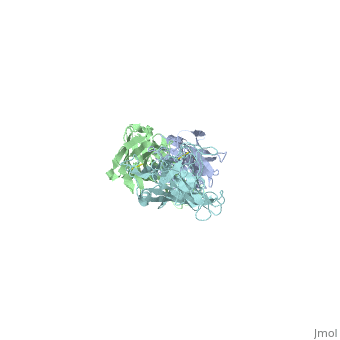OspA
From Proteopedia
(Difference between revisions)
| Line 5: | Line 5: | ||
| - | It is a borrelial protein that colonizes within the transmitting tick host midgut. Lyme disease | + | It is a borrelial protein that colonizes within the transmitting tick host midgut. Lyme disease is a progressive infection resulting from inoculation of the spirochete ''B. burgdorferi'' into the skin by a feeding tick, usually species ''Ixodes'' ("Crystal Structure 2012). If left untreated, it may progress in many stages beginning from minor symptoms like rash, commonly seen as a bull-eyes rash and then progress into serious, lifelong disabilities. One of the autoimmune processes that trigger an inflammatory response occurs from the endurance of borrelia in the host. It is known to cause demyelinating diseases in the Central Nervous System (CNS). Once the borrelia is in the CNS, OspA is up regulated for the sake of adhesion to the area (Durovska 2011). Initially, OspA is down regulated upon infection of the host but it is up regulated again in the different envirnments of the host of the Cerebral Spinal Fluid (CSF). It is hard for our immune system to attack the borrelia because there is an inactivation of the effector mechanisms and also because of the borrelia hides in less accessible compartments in our body (Rupprecht 2008). The main mechanism of protection is the blockage of borrelia transmission from tick to host by anti OspA antibodies (de Silva 1996). However, further studies need to be done in order to improve the OspA based vaccines. |
| Line 23: | Line 23: | ||
"Crystal Structure of Lyme Disease Antigen Outer Surface Protein A Complexed With an L-Fab." Crystal Structure of Lyme Disease Antigen Outer Surface Protein A Complexed With an L-Fab. Web. 20 Apr. 2012. <http://www.pnas.org/content/94/8/3584.full>. | "Crystal Structure of Lyme Disease Antigen Outer Surface Protein A Complexed With an L-Fab." Crystal Structure of Lyme Disease Antigen Outer Surface Protein A Complexed With an L-Fab. Web. 20 Apr. 2012. <http://www.pnas.org/content/94/8/3584.full>. | ||
| + | |||
| + | |||
de Silva A M, Telford S R III, Brunet L R, Barthold S W, Fikrig (1996) J Exp Med 183:271–275 | de Silva A M, Telford S R III, Brunet L R, Barthold S W, Fikrig (1996) J Exp Med 183:271–275 | ||
Revision as of 04:50, 1 May 2012
| |||||||||||

